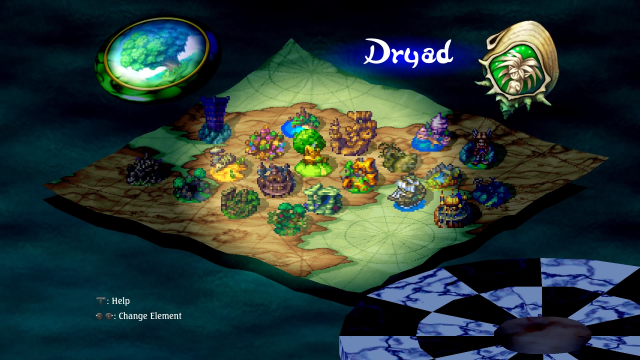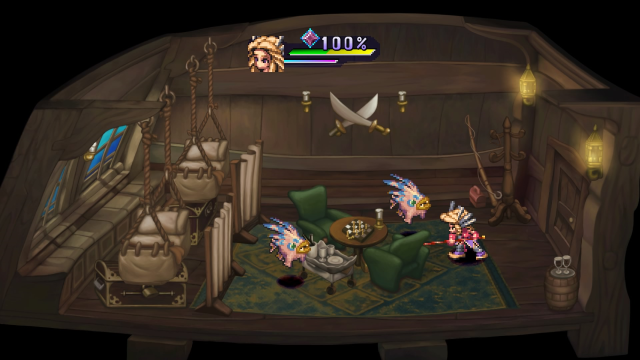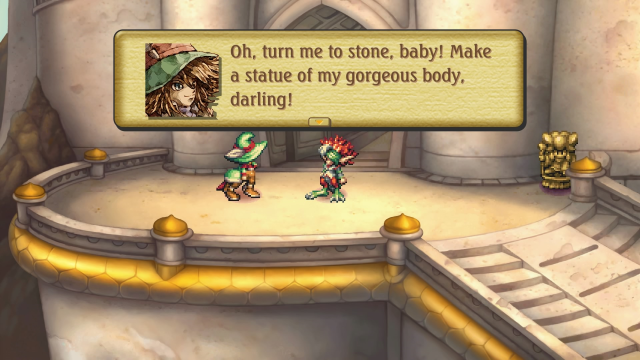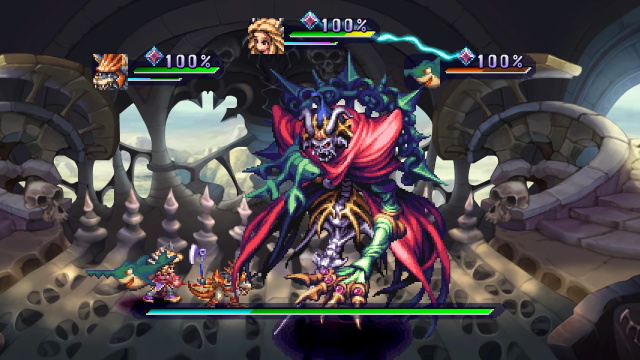Those who were around and into RPGs in 2000 probably remember Legend of Mana as a game that stumped reviewers and players alike. It simply didn’t go out of its way to explain how it worked, nor did it give repeated hints about where to go or what to do.
The obtuse nature of Legend of Mana goes against the grain of previous entries in the series, which are very linear in comparison. This may be due to the involvement of Akitoshi Kawazu as producer, who is best known for his work on the befuddling SaGa series.
It can be confusing to figure the game’s systems out the first time around, and deciphering how to complete a quest can sometimes be a bit of a brain-tickler. Ultimately, Legend of Mana is a game that’s more style than substance, and that style is great. Much like Chrono Cross, which came out a mere two months later, it’s hard not to recommend this game, but it’s not the gameplay that made Chrono Cross, and likewise Legend of Mana, memorable.
Legend of Mana Review — All a Dream
As is customary in Mana, Legend of Mana is about saving the Mana Tree. As isn’t custom in Mana, the game mostly revolves around the lives of the world’s quirky inhabitants and progressing the way you want to.
There are three overarching story paths you can follow in a single playthrough, with the path you choose determined by the choices you make in conversations and the places you go. However, the ending doesn’t really change based on the route you choose.
This sort of non-linear storytelling and progression is typical in the SaGa series, but this is the only entry in the Mana series that approaches its story this way.
The lack of direction can be troublesome, but luckily, the game isn’t terribly punishing. The ability, technique, and magic systems take a little trial and error to learn, and progressing the story usually requires you to pay attention to dialogue so you know where to go. Those bits aren’t surprising.
The ‘Land Make’ system is where you may trip up the most. As you progress, you’ll obtain Artifacts you can place on the world map to visit. Their placement does matter for some quests, and they affect the Mana in an area, as well as shop inventories.

Between the Land Make system and the various routes for completing the game, there’s a lot of flexibility to be found in Legend of Mana and potential for repeated playthroughs.
If you’ve played any classic Mana games, you will be very familiar with the sluggish combat in Legend of Mana. Despite being an action RPG, Legend of Mana‘s combat system is slow and unresponsive — which is typical of the series, but something to note for those unaware.
You can carry one of 11 different weapon types into battle, each with its own speed, range, and techniques to learn. You can also equip an instrument to one of your technique buttons and use the magic they bestow.
In battle, you’ll be mixing up movement abilities and regular attacks along with magic and techniques to defeat the monsters and general baddies standing in your way. You’ll just be doing it quite slowly. Combat tends not to be the focus of your adventure. Sure, you’ll be fighting plenty; but you wouldn’t be bothering if not for the denizens of Fa’Diel.
An added bonus is the ability to turn off encounters, which won’t help you when first venturing into an area but sure as heck turns into a boon when you start having to backtrack. Which you’re going to do a lot of.

For its time, the dialogue in Legend of Mana was surprisingly well localized and each of the NPCs you come across in passing or have prolonged dealings with has its own unique personality to endear or repel you. Luckily, it’s usually the first option.
In the visual and audio department, Legend of Mana is no slouch.
The music for the game has always been great, and the new remastered tracks are decided improvements over the originals, and you can choose between either one at any time via the pause menu.
All of the game’s backgrounds have been fully remastered and are flawlessly converted from the original pixel backgrounds, while the character and enemy sprites are as detailed and vibrant as ever.
Individually, I have no complaints on this front, but they are a bit jarring when mashed together due to the detailed nature of the sprites. An option for classic backgrounds would have been wonderful, but it’s understandable why that would not be included.
Legend of Mana Review — The Bottom Line

Pros
- Fa’Diel is almost like a painting you can play in
- The combat system is flexible and party members memorable
- The visuals and audio are both a dream-like treat
- The ability to turn off encounters makes backtracking far less torturous
Cons
- Combat is slow and at times unresponsive…
- … it’s also very easy
- Progressing may be a bit too obtuse, and unrewarding, for many
Legend of Mana is a game I fell in love with when it was initially released all those years ago and coming back to it today has been a treat, but I must admit: a large portion of my enjoyment may be the nostalgia of the thing rather than the thing itself.
This wasn’t something I felt when playing the Trials of Mana port (not the remake) on the Nintendo Switch, as the class and party system carry it well enough for my tastes that I’ve played it more times than I’ll admit. Though that, too, may just be nostalgia.
Legend of Mana is vibrant and flexible in all the right ways for my preferences today, and I certainly fancy the game personally. The sheer slowness and obtuse nature of it may be too much for some players. There’s a lot to see in Legend of Mana, but the experience never feels fleshed out. Fa’Diel is beautiful and enticing and hard to forget, but not because of the gameplay that binds it together.
[Note: Square Enix provided the copy of Legend of Mana used for this review.]










Published: Jun 28, 2021 03:22 pm